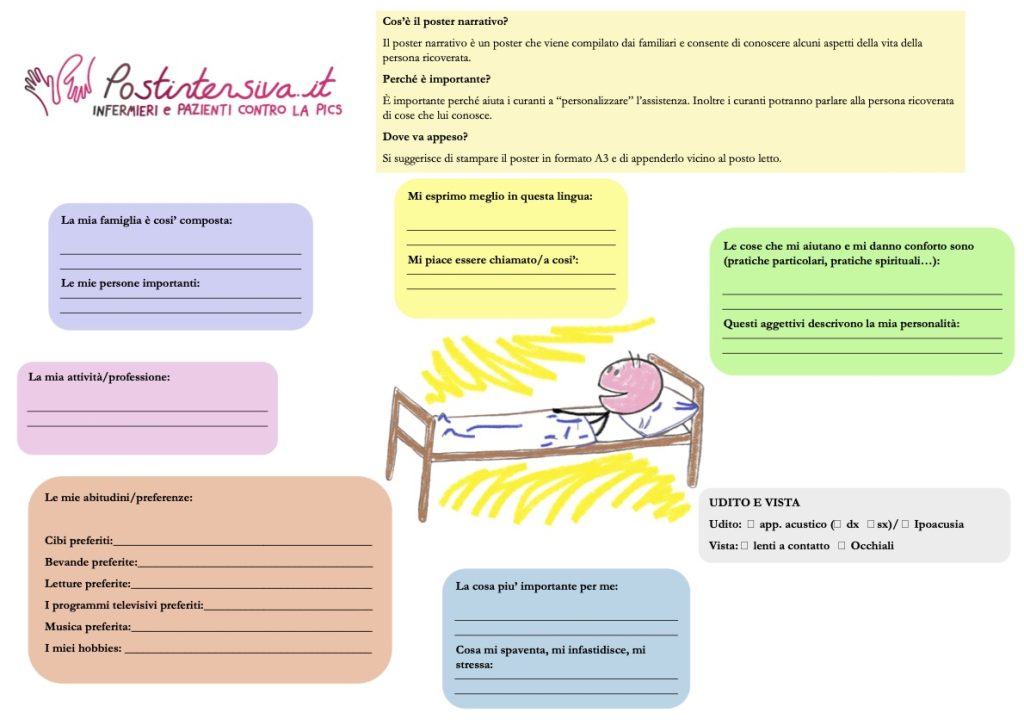
Sergio Calzari, born in 1979, is an intensive care nurse at Cardiocentro Ticino in Lugano, where a group for humanization of care has been in place for a few years. For the past two and a half years they have been implementing the patient diary and the “narrative poster” (or get to know me board) whose operation and purpose he tells us about today.
People suffering from a serious illness, such that they need to be admitted to an intensive care unit, find themselves, by definition, in a condition of fragility: fragility of organs and apparatuses. The person is then catapulted into a “parallel world,” that of the ICU, made up of cables, monitoring, alarm sounds. A world very often made up of “nakedness” (or near-nakedness) that allows even a possibly distracted eye to notice the condition of fragility and extreme vulnerability in which the person finds himself.
Let us now try to imagine that we are the caregivers of that person. To arrive in the morning and find a semi-naked body in a bed, with a tube coming out of the mouth and with many other wires and cables. A body that does not respond, does not perform what is required, does not interact with us; perhaps with muscles paralyzed by a curare. Imagine having to “manage” the vital functions of that body, having to wash it, fix it, move it, move it….
The risk of these situations, for us caregivers, is that we can no longer see beyond that body. We risk annihilating human frailty by equating it with the frailty of organs and apparatuses.
And the various fragilities of organs and apparatuses have various names; they are called respiratory failure, liver failure, heart failure, colon carcinoma, aortic aneurysm… And so Mr. Mauro becomes the respiratory failure in bed 1, or the covid in bed 5 or the anterior infarct in bed 2.
In the Anglo-American world, they have understood that with a few tools, which are simple, easy to use and do not require additional resources, it is possible to humanize care in intensive care units by allowing caregivers to put the person back at the center of care and by allowing those immobile bodies that are so dependent on everything to be given back their proper name as a person. I wonder why in Italy intensive care is still so inaccessible and so little importance is sometimes given to the various aspects of humanizing care.
One of the tools that is widely used in Anglo-American countries and, needless to say, so little used in Italian intensive care is what they call in English the “get to know me board” or the “all about me” poster. At the Cardiocentro Ticino Institute we call it the “narrative poster,” considering it for all intents and purposes a narrative medicine tool.
It is a very simple poster that is proposed and filled out by the family members of the hospitalized person and contains information about the person’s life. Information such as work activity, hobbies, personal interests (reading, movies, favorite sports, etc.) are noted. The poster is then hung at the bedside. In this way, alternating caregivers can learn something about the person.
There goes the “respiratory failure” of bed 3, a sedated and medicated patient, back to Mr. Mauro, a bank clerk who is a soccer fan and loves hiking in the mountains; he has two children and owns a German shepherd named Arturo who accompanies him everywhere.
Once the acute phase has passed, caregivers can then personalize care for Mr. Mauro, who refuses food, by offering vanilla ice cream and making him listen to his favorite music.
At times when Mr. Mauro is delirious and with altered consciousness, he is asked to tell about Arturo, the German shepherd dog, and the two children waiting for him at home.
The post-intensive care portal postintensive care.it has created a version of the narrative poster that is made available free of charge for those who would like to implement (or initially just try to use) this simple tool in their own intensive care unit. The proposed version is ready to be printed (possibly in A3 format).
We remain hopeful that the various ICU humanization tools can be increasingly disseminated and used in Italian intensive care units.

